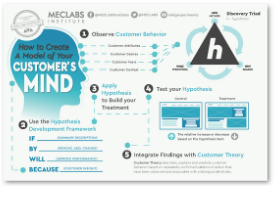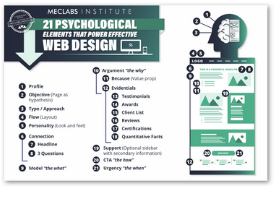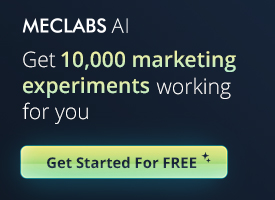
Quick update to a MarketingSherpa Case Study from March 2001. 10,000 Subscribers Pay $10 Each for “PLUS!” Edition of the Free LangaList Email Newsletter describing ezine Publisher Fred Langa’s first few months of transition from free to for-fee.
According to a story in today’s eBusiness Secrets, Langa now has 145,000 free subscribers, 19,000 of whom have anted up the $11-$12 annual subscription fee. That’s a bit more than a 13% conversion rate – which is unusually high, however, Langa’s price is unusually low.
Is it worth lowering your price to try to get more buyers? My new Tech Editor Alexis Gutzman just reminded me that research shows about 25-30% of online customers require some type of customer service. Perhaps they email you, or there are credit card snafus, or whatever, so you have to add that cost in whenever you are considering growing your subscription file. More customers means more customer service costs. (Not that I don’t fully appreciate what Langa is doing — he rocks.)
http://www.marketingsherpa.com/article.php?ident=22521
http://secretspro.com/ebusinesssecrets
http://www.langa.com

Do you know what a “locator” is? How about “PRM software?” I’m relatively technical, and while I could guess them both, neither is a top of mind term/acronym for me. Yet, two companies who sell these two products have sent out e-mail marketing in the last week or so assuming I was just thinking about their solution. Neither bothered to offer an alternative description of the product in the opening lines, so that I could read the first paragraph and surmise what their solution did, even if I didn’t know their term for it.
Apositives were created for just this purpose. Try this: “Thinking of revamping your locator, the tool on your site that visitors use to find the store closest to them?” Or this: “SelfImportant Research Associates reports that 47% of companies that need PRM software don’t have it. Are you one of the 47% that isn’t managing its partner relationships well enough?”
If you think you’re marketing to such a qualified audience that you don’t need to define the terms, you’re wrong. The fact that I once had a conversation with your PR guy about your term or acronym doesn’t mean it’s been stored away for easy recall. Make it easy for your audience to nod along with you — define your terms and your product early in your messages.
AuthorizeNet, a merchant account processor for thousands of online retailers, decided recently that credit cards issued by banks outside the US are not a good risk this week. So this evening at 9pm ET, they turned off the ability for every single one of their merchant customers to accept non-US cards. Luckily they did send three email bulletins to customers prior to this. It was still a major inconvenience.
Here at Sherpa we had to send someone back to the office three hours after closing, to go online and manually turn our AuthorizeNet settings back to accept non-US cards again. During the few minutes that took, three Sherpa shoppers from Canada all had their perfectly good credit cards declined. I understand the need for security online these days, but come on! Are Canadians less trustworthy than Americans? I think not.
Are your non-compete contracts with departing editorial staff (or former publication owners) as thorough as they need to be? I’ve definitely noticed a trend these days of folks who are under editorial non-compete after they leave their companies, starting an email newsletter and growing an opt-in list while they twiddle their thumbs waiting for the non-compete to end. Then, the day it does, they flip the switch and all the readers they’ve gathered on that free opt-in list (many of whom include your long-term buyers) suddenly get an offer for a subscription product that looks like yours, smells like yours, but perhaps undercuts yours a bit on price. So, double-check that non-compete language to make sure it includes all sorts of writing and publishing, not just print and/or for-fee.

Ouch! Leading industry publication DM News (who publish iMarketingNews) just shot themselves in the foot. They’re renting their opt-in email list out to various vendors. This isn’t a mistake. The mistake is the “From” line on the messages. The message I just got said it was from “Edith Roman”.
This is a fairly common mistake these days, so let me clear it up. According to focus group results, up to 50% of email recipients look at the “from” line to decide whether or not they will open an email or delete it. If the “from” line is not from someone they remember asking to get email from, many will promptly assume that company is spamming them — even if it’s not officially spam. In the world of spam, everything is in the eye of the beholder.
When you rent a list, the “from” line should be the brand name or company name that the opt-in names will remember as the place or company they gave permission to email them from. Your only other choice — and this falls into the debatable grey area — is a brand name that’s really, really famous, so recipients would be inclined to trust and open email from that brand even though they can’t remember asking for that brand to email them personally.
In the case of this campaign, The smarter bet would have been to use a From line saying, “DM News.”
I just got a smart email campaign from Business 2.0! Why smart? I guess they’ve heard that a lot of business people these days assume anything HTML is junk mail and dispose of it accordingly. However, they wanted to be able to track their email campaign’s open rate, which you can’t do if you’re sending a plain text message. So, Business 2.0’s marketers did the best of both worlds. They sent an email letter that looks like plain text, but is actually HTML.
The campaign is in the form of a thank-you letter from the editor to the magazine’s readers. And I must say, although I know intellectually that it’s a mass email, I still felt an emotional impact from receiving something that looked personal — a regular typed note, vs. something with graphics and colors. Well done.
It loads a bit slow, but this PDF newsletter from e-subscription tech firm SandLot features a fun front-page article everyone selling subscriptions online will enjoy. The article briefly describes results of recent Fulcrum Analytics research into who’s most likely to buy content online, and what sort of content do they buy. (If you were rooting for young sports fans to win the jackpot, you’d be right on the money.)
http://www.sandlot.com/sandlotreview/SR-Jan2002.pdf

Lillian Vernon (the company, not the woman) tells me they are increasingly bullish on Web sales replacing catalog orders. After September 11, department stores were able to mark down their prices to reflect consumers’ newfound reluctance to spend. Since their holiday catalogs were all either being printed or in the mail, they didn’t have too much flexibility to change prices. What they decided to do was an e-mail marketing campaign to their opt-in list, offering 20% off retail on anything in the store. The conversion rate was 10 times the usual for an e-mail campaign. As the holidays drew nearer (and department stores cut prices further), they increased the offer to 25% off, with similarly stunning results. In case you live in a cave without a mailbox, Lillian Vernon has 8 catalogs with 24 million customers’ addresses.
They’re not yet collecting e-mail addresses from their phone order center — the next obvious step. They told me that when they did a three-day trial asking customers (to the phone center) for their e-mail addresses, 30% of callers had e-mail addresses, and 60% of those wanted to be contacted by e-mail (opt-in). Lillian Vernon, famous for personalized coasters, and other stuff you’d find at Grandma’s house, would not seem to be a particularly tech-savvy audience, so 30% sounds pretty good to me.
Per my Blog from a few months ago, eFax has begun to fight harder against fax spam. Today they announced a service, all eFax customers who receive faxes they suspect to be spam can report them to abuse@mail.efax.com.
Pesach Lattin, editor and publisher of the generally irreverant AdBumb newsletter for online media buyers and brokers, just sent out an emergency bulletin revealing that NextCard, one of the Web’s largest advertisers, has just been shut down by Federal regulators for “unsafe and unsound practices.” Please note: the practices that were unsound were not their advertising methods, but rather their financial practices.









